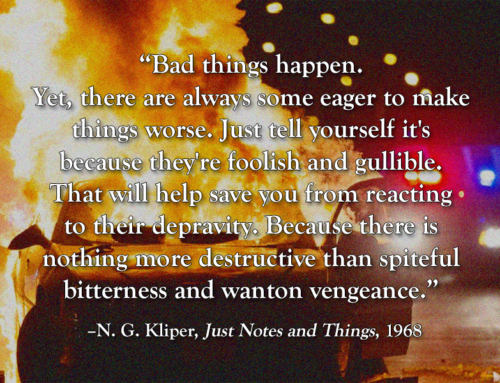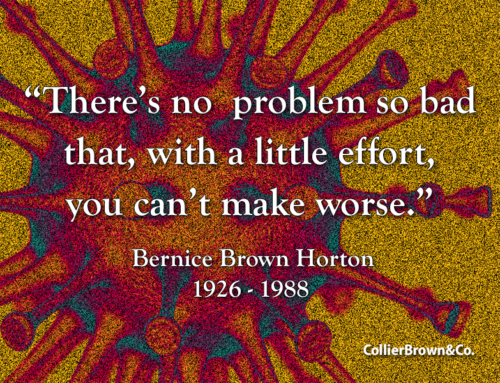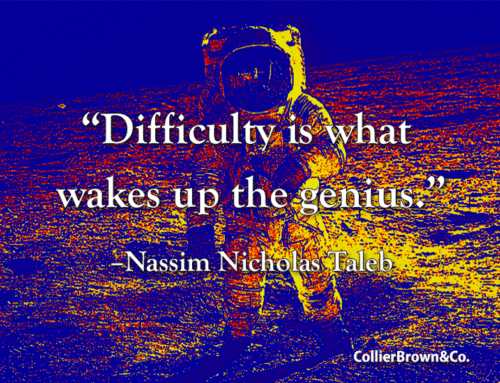Some years ago I was returning from Montreal to Atlanta after a consulting project. The airplane had a scheduled stop in Boston. Prior to our landing the pilot informed the passengers of “terrible” crosswinds at Boston’s Logan Airport and that we could expect a “bumpy” landing. Understatement on both points.
We survived. This, only after the pilot fought a tremendous (and thankfully victorious) fight to keep the upside up and straight-ahead, well, straight-ahead. The passengers took notice of the struggle.
Later, on the leg to Atlanta I reflected on the pilot’s struggle and how it mirrored much of the project I had just left. The pilot had a clear destination in mind for the plane. Yet his best efforts were challenged by powerful forces – gravity, crosswinds and turbulence. He had to remain highly focused to keep the plane upright and on a straight trajectory and glide path with the runway while he maintained appropriate altitude and airspeed. He had to balance multiple competing forces and make constant adjustments to keep the plane in horizontal and vertical alignment to get his passengers safely to their destination.
My client knew exactly where he wanted to take his business; his end-in-mind was clear and well articulated. Yet, it just wasn’t happening. His company was being buffeted by turbulent market shits, a loss of internal energy and direction, and an uncomfortable sense that the “ride” had become dangerous.
Copyright 1993, D. Brent Anderson & John C.Horton
After some diagnostic work, we started at the beginning – following the model above – with his customers and developed a current and comprehensive understanding of their realities, wants, and needs. By the way, my client was quite surprised at how much things had changed.
This new information prompted a strategy modification, as well as some changes in business processes that enabled faster and more effective deployment of the strategy. Like an airplane landing in high crosswinds, it seems that everything is fast and fragile these days. Mark Parker, CEO of Nike says, “Things are accelerating… It’s a high-velocity world, we’re digitally connected, everything is changing.”
During a changing environment, while recalibrating with customers and reengineering some internal processes, the CEO revisited the company’s raison d’être with the entire staff in a series of “open forum” meetings all around the company. We invested the time and effort in Purpose/People alignment to reconnect the “why” with the “who” and generate more energy and engagement. Thankfully, the client was open to ideas from all over the company, especially when it came to process improvements that better served customer needs.
I’ve always maintained fairly low, but non-negotiable expectations about airline travel: I want an equal number of take-offs and landings; no odd numbers please. And, any landing you walk away from is reasonably successful. My client’s expectations were slightly higher for our project. Interestingly, perfection was not on his list of wants. He wanted to make progress and make a difference; that is, improvement in the numbers (for the results to profitably meet the wants and needs of his customers), and to have a more adaptive organization with the willingness and ability to make the constant adjustments (alignments) necessary for a safe and secure landing, time and time again. He succeeded and my expectations for airline travel have not changed.
In Other Words…
“Change begets change. Nothing propagates so fast.” – Charles Dickens in Martin Chuzzlewit, Chapter 18 (1844).
“Great things are not done by impulse, but by a series of things brought together.” – Vincent Van Gogh
“Inertia is a powerful force in successful enterprises. It takes effort to stand in the future and see new possibilities” – Larry Keeley
“But the nearer the dawn the darker the night,
And by going wrong all things come right;
Things have been mended that were worse,
And the worse, the nearer they are to mend.” – Henry Wadsworth Longfellow, Tales of a Wayside Inn (1863-1874), The Baron of St. Castine, line 265.
“I don’t have a fear of flying; I have a fear of crashing.” – Billy Bob Thornton
In The Word…
“To the weak I became weak, to win the weak. I have become all things to all people so that by all possible means I might save some.” 1 Corinthians 9:22









Leave A Comment